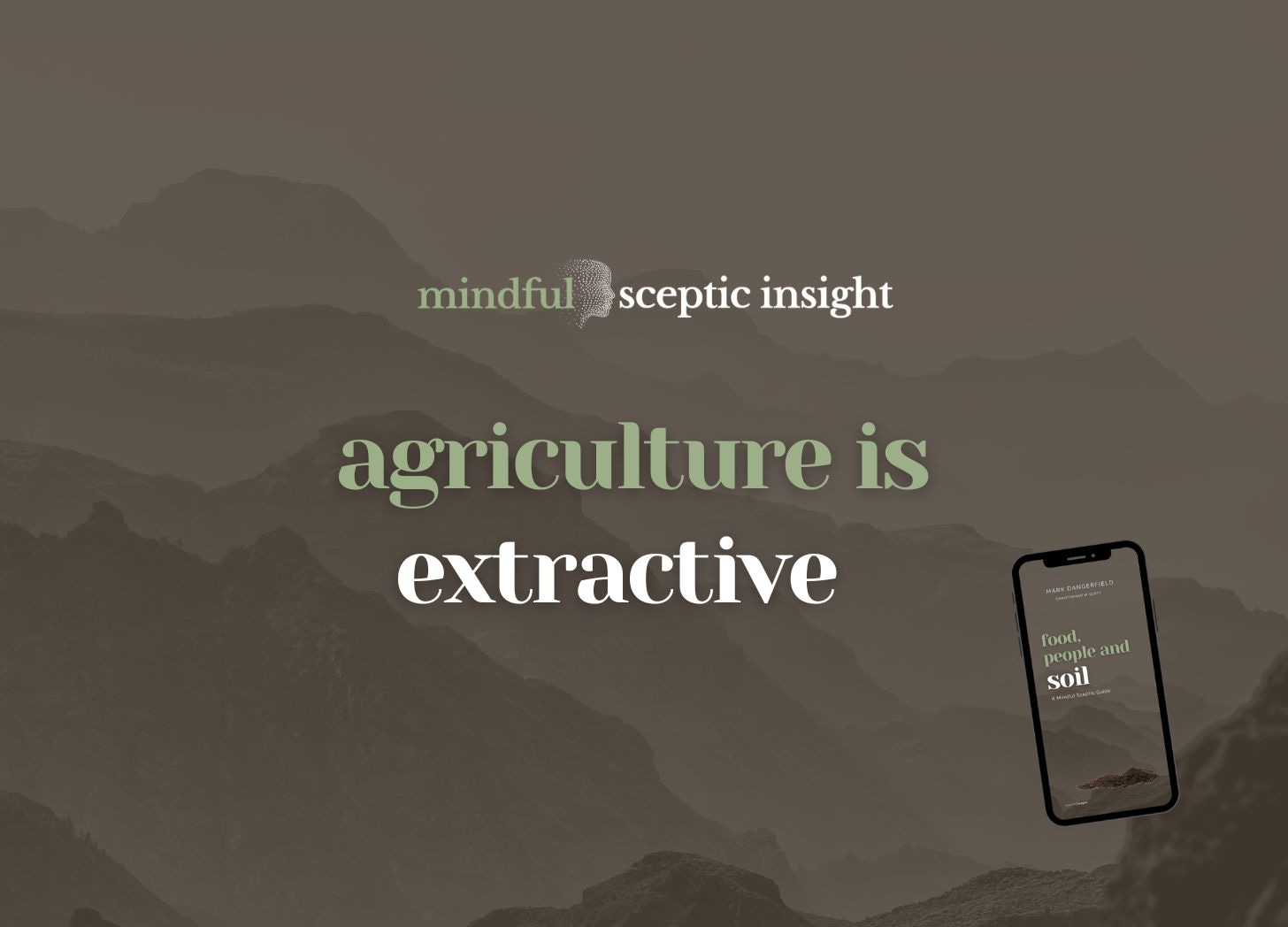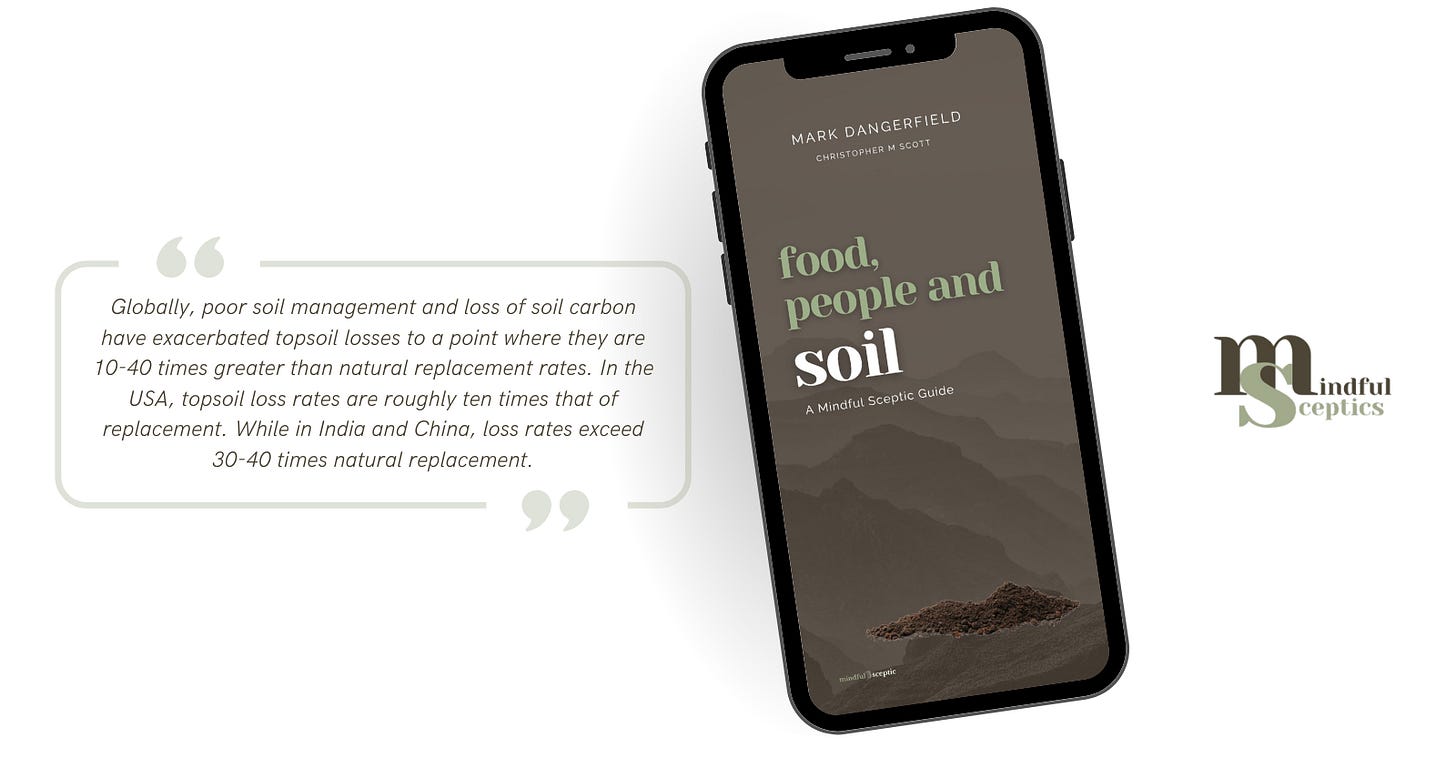Agriculture Is Extractive
Removing biomass makes linear realities persist over circular promises
Core Idea
Agriculture has always been, at its foundation, an extractive enterprise. From the first cleared fields in the Fertile Crescent 12,000 years ago to today’s industrial operations, farming systematically removes nutrients and biomass from the land to feed humans elsewhere.
This is not about poor management or some error by the farmers; it’s a feature of agriculture itself.
Every harvest represents a net outflow of nutrients from the soil. Every grain of wheat, every head of lettuce, and every apple contains phosphorus, nitrogen, and trace elements that must be replenished for the system to function properly.
The mindful sceptic recognises that even the most well-intentioned farming practices cannot escape this fundamental reality.
Advocates for regenerative agriculture promise a return to sustainable harmony with natural systems. But this overlooks the reality that natural systems don’t export their productivity to cities. Agriculture, by definition, does.
Counterpoint
The standard regenerative narrative has cover crops fixing nitrogen, diverse rotations building soil, and holistic grazing mimicking natural processes. And done right, these farming practices can enhance rather than degrade the land. Soil carbon increases, biodiversity flourishes, and the need for external inputs all but disappears.
But this misses the scale of the enterprise. Even the most regenerative farms still ship their produce to market.
That carrot leaving the field takes with it nutrients that originated in the soil. That grass-fed beef embodies phosphorus and trace minerals extracted from the pasture. Without continuous inputs from composted urban waste, imported fertilisers, or atmospheric nitrogen fixation, the system runs down.
The regenerative movement conflates biological activity with sustainability. A farm can be biologically vibrant while still being nutritionally extractive. Soil microbes and earthworms cannot create phosphorus from thin air, no matter how healthy the ecosystem appears.
Here is the thing.
Any system that exports more nutrients than it naturally receives will eventually deplete. Regenerative practices can slow this process, make it more efficient, and even temporarily reverse it, but they cannot eliminate the fundamental extraction that defines agriculture.
Thought Challenge
Do the nutrient audit. Pick a regenerative farm you’ve read about. Calculate the nutrients leaving the farm in harvested crops and animal products. Then identify where replacement nutrients come from. Is the system truly closed-loop, or does it depend on inputs from elsewhere?
Apply the time test. Take any agricultural practice. From ancient terracing to modern permaculture, ask this question. Could this system maintain current productivity levels for 1,000 years without external inputs? What would need to be true for that to work?
Both these exercises reveal the tension between agricultural productivity and long-term sustainability. They acknowledge that even regenerative systems depend on energy and nutrient flows that must originate from somewhere.
A reflection
Being a mindful sceptic about agriculture doesn’t mean dismissing efforts to farm more sustainably. Regenerative practices genuinely improve soil health, reduce erosion, and enhance biodiversity. These benefits matter enormously.
Indeed, I hesitate to call out an essential upgrade to intensive systems. But to pretend that any form of agriculture can escape thermodynamic reality is foolish. Nutrients extracted must be replaced. Energy borrowed must be repaid.
The question isn’t whether agriculture is extractive—it always has been. The question is whether we can manage that extraction within planetary boundaries.
Evidence Support
Montgomery, D. R. (2007). Soil erosion and agricultural sustainability. Proceedings of the National Academy of Sciences, 104(33), 13268-13272.
TL;DR… quantifies how conventional agriculture has accelerated soil erosion rates far above natural replacement levels, resulting in ongoing soil fertility loss and endangering long-term productivity. Data shows rates of topsoil depletion due to crop harvesting exceed natural formation by ten times or more in many regions.
Relevance to insight… directly supports the insight’s claim that agriculture systematically removes nutrients and biomass, outpacing natural replenishment, making it inherently extractive. The findings underscore the extent to which farming depletes topsoil and associated nutrients, regardless of management practices.
Pimentel, D., & Burgess, M. (2013). Soil Erosion Threatens Food Production. Agriculture, 3(3), 443-463.
TL;DR… estimate global soil erosion rates at 10–40 times above natural replacement, with nutrient losses and productivity declines consistent across diverse agricultural systems. They detail the link between nutrient extraction in harvests and the need for replacement via fertilisers.
Relevance to insight… agriculture as a net exporter of essential elements, leading to long-term declines in fertility and requiring continual inputs to maintain yields. It reinforces the extractive nature of farming regardless of geographical context.
Smil, V. (2000). Phosphorus in the environment: Natural flows and human interferences. Annual Review of Energy and the Environment, 25, 53-88.
TL;DR… details global phosphorus dynamics and documents how agricultural harvests deplete soil phosphorus stores. The work highlights the impossibility of maintaining fertility without continued external replacement, as crop removal exceeds natural inputs.
Relevance to insight… Phosphorus is non-renewable on practical timescales; this research provides clear chemical evidence that farming consistently draws down irreplaceable stores. Its conclusions echo the insight that nutrient export via agriculture cannot be overcome by biological vibrancy alone.
Foley, J. A., et al. (2011). Solutions for a cultivated planet. Nature, 478(7369), 337-342.
TL;DR… global analysis quantifies the nutrient and energy flows out of farms and the environmental costs of meeting those demands with synthetic fertilisers and other inputs. It points out that sustainability depends on carefully managing these extractive flows within planetary boundaries.
Relevance to insight… supports the argument that agriculture’s very definition involves extraction. It underscores that all proposed improvements must reckon with the fundamental challenge described in the Mindful Sceptic insight.






